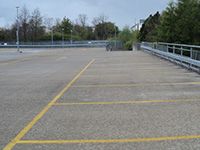Protective coatings have been commonplace in multi-storey car parks for the last 30 years or so. Waterproofing systems for external decks and coatings for internal decks provide protection from water ingress, chemical attack such as chlorides from de-icers and carbonation, plus mechanical damage from vehicle movements. In doing so, they can improve health and safety for pedestrians and vehicles by increased anti-skid character and enhance the aesthetics of the facility.
Overlaying a coating has benefits
They don’t however last forever. Over time problems with existing coatings that can be observed include wear, delamination, cracking and contamination. When it comes to refurbishment there are two approaches to consider: full removal and replacement, or test and overlay. The preference should be to overlay the coating with another coating for the following reasons...
No compromise to concrete cover
Overcoating an existing coating means that there is no strip up of an existing coating required. Removal of any coating is normally by mechanical means, such as planning, scarifying or shot blasting. A byproduct of this process is that the substrate, usually concrete or asphalt, has a few millimeters removed too. Whilst this doesn’t seem too impactful, this could be repeated multiple times over the structure’s lifetime. Consequently, the original concrete cover, carefully designed to protect the underlying structural steel reinforcement may be compromised, leaving it more susceptible to chloride attack and carbonation and structural vulnerability.
Less risk of outgassing
The concrete driving surface of many multi-storey car parks usually has a finished concrete surface formed during installation. This finer surface texture is created during the finishing stage by tamping, floating and then brushing, and serves to seal the surface of the concrete. When coating such car parks, the sealing finish layer is removed by mechanical means. This exposes the main body of the concrete, and opens the capillaries within. This can potentially allow air and moisture to get in, and outgassing to occur. This exposed concrete can pose problems for many coatings, leading to reduced cohesive strength, reduced adhesion which may induce micro blisters in the coating, which in turn may give rise to water ingress.
No waste disposal considerations
Conversely, overlaying an existing coating can allow a much shorter project timescale with minimal disruption, and a quicker return to income generation for the car park. Furthermore, there is no coated concrete or asphalt to dispose of. Currently these components cannot be separated which means that disposal is becoming increasingly expensive to handle.
A scientific approach to overlaying an existing coating
Ascertaining whether an existing coating is suitable for an overlay with a new system requires a scientific approach. This should include extensive adhesive and cohesive strength tests, as well as an understanding of the car park structure, its stresses and movement. Whilst some areas may need repair, its far more cost effective to localise repairs and then overcoat, rather than impact the whole surface with invasive removal.
For some systems such as Triflex PMMA-based systems, overlay again sometime in the future is quick, simple and minimises disruption. Just a simple cleaning step prepares the Triflex protected surface for a further Triflex coating some decades later, supported with a new Triflex Materials Warranty. With systems tried and tested for decades throughout the UK and Europe, overcoating a coating is a proven approach.


